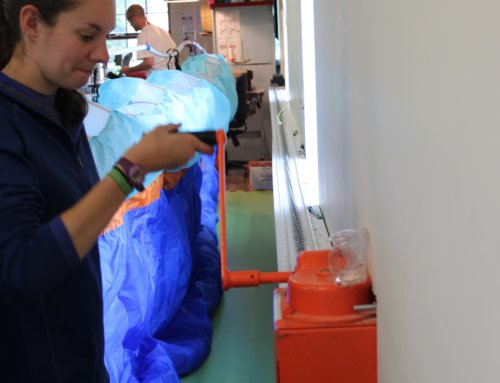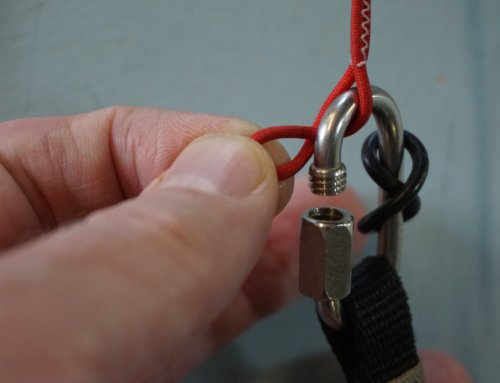Line material and trim checks
Most of us are aware that our lines can be both sheathed and unsheathed, and that the material can be either Kevlar or Dyneema. There is also a third type of material, Vectran, which is being used by some manufacturers. But how do the different types of material perform, both when new and over time?
Kevlar and Technora are brand names for types of para-aramid material. The “ar” part of “aramid” comes from “aromatic”, signifying the presence of a hexagonal carbon ring in the chemical structure, and “para” denotes that the ring is attached to the molecule chain at two points of the ring opposite each other; “amid” is an abbreviation of “polyamide”, which means a very large molecule with a recurring nitrogen-carbon-oxygen component in the polymer chain. Still with me? Silk and wool are examples of naturally occurring polyamides. Kevlar was developed in the 70’s as a lightweight replacement for steel in racing car tyres, and has a tensile strength more than five times that of the same weight of steel. It has since found applications in diverse fields ranging from body armour to hifi loudspeaker cones. UV causes it to break down, so sheathing or some form of protection is essential.
Dyneema, and its brand competitor, Spectra, are made from filaments spun from ultra-high-molecular-weight polyethylene (UHMWPE), a high-tech variant of the material used to produce the humble polythene bag. In this form it has a strength to weight ratio some eight times that of steel, and will float on water. Exceptionally lightweight and extremely strong, it also has very low friction (comparable to Teflon) and very good abrasion resistance. In solid form it is used for replacement hip joints, and as Dyneema, competes with Kevlar to be used in the manufacture of bullet proof vests. Its main weakness results from a relatively low melting point, and heat can cause it to shrink.
Vectran is produced from an aromatic (carbon rings, remember?) polyester (this is a large hydrocarbon molecule which includes oxygen, whereas polythene is made of just carbon and hydrogen). After reading all that you’re prepared for the next organic chemistry round of University Challenge. In case Trivial Pursuit is more your thing, Vectran is a key component in two prototype inflatable spacecraft, Genesis I and II, that have been in orbit for the last ten years. Vectran is thermally stable like Kevlar, and also shares its susceptibility to UV.
Paraglider lines made from each of these three types of line are strong and light, and typically stretch by only 3 – 4% before reaching their breaking limit. In unsheathed form, Dyneema is more abrasion resistant than the other two materials, but it is only over time that significant differences between the materials become apparent.
Based on our experience in the workshop, it’s clear that Kevlar lines lose their strength more quickly than Dyneema. We suspect that Vectran performs similarly to Kevlar in this regard, but we have comparatively little data on this material yet. Niviuk, Gradient, Sol, Axis and MacPara began using unsheathed Vectran a few years ago, and Aerofix holds stock of this material to be able to replace damaged lines. In terms of strength loss, after the EN standard 5,000 bending cycle test, Dyneema retains 80% – 90% of its original strength, whereas Kevlar falls to 50% – 60%.
I was interested to compare the strength of lines of the different types of material, both when new and after the bending test. For any specified maximum breaking strain in kilograms, how thick a line is needed? And how does the answer differ when the line is no longer new? The graphs below summarise an analysis of data set out in Liros’ line catalogue. Since Liros only manufacture Kevlar and Dyneema lines, I was unable to examine Vectran for now. [Chart]
Unsurprisingly, when new, to take the same load, sheathed lines will always be thicker than unsheathed lines, for either material. Unsheathed lines of both Dyneema and Kevlar need to be of similar diameter for any given load. However, after taking into account the loss of strength after the bending test, a significantly different picture emerges.
For lines that need to carry a load of 100kg or more, such as main lines, Dyneema lines can be thinner that either sheathed or unsheathed Kevlar lines. For mid and upper lines that do not need to handle such a high strain, the unsheathed variants of both types of material appear to perform similarly.
So for a lineset that has been well used, it looks like drag will be minimised using unsheathed mids and uppers of either material. The best choice for the main lines is Dyneema, and given the minor penalty in terms of diameter, probably sheathed for protection. That’s exactly the strategy used by, for example, Ozone for the Rush and their other A and B rated gliders. So why would other designs take a different approach?
Well, one of the main reasons is dimensional stability over time. It’s well known that Dyneema (and Vectran) lines settle in during the first 20 to 50 hours of flying. Typically all Dyneema lines shrink a little over this period, but the rear, less heavily loaded lines, move by more than the A and B lines. NOVA recommend a trim check at that point, as do Niviuk for their Peak, which uses Vectran. Other manufacturers like 777 recommend adjustment to the loops at the maillons after a similar time. In contrast, Advance explained that their reasoning for adopting unsheathed Kevlar for the Iota was that the lines would not shrink or stretch.
Our experience in the workshop tends to confirm this perspective. It is fair to say that Kevlar linesets are less likely to need to be adjusted. That’s not to say that the trim on gliders with Kevlar lines never needs to be adjusted, as they can and do go out of trim over time. And equally, it’s important to remember that Kevlar lines in particular do need to be checked to ensure they remain strong enough.
If you want to chat anything through, we’re always happy to offer help and advice over the phone (01433 627195) or by email (info@aerofix.com).



